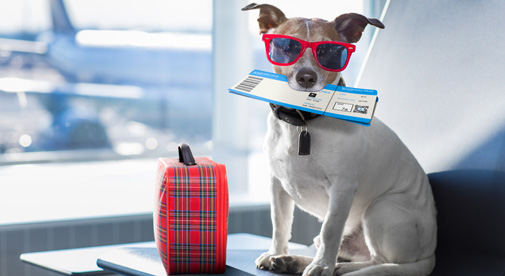I was talking to a sassy American woman on the cusp of retirement. She was buying my car and asked why I was selling a fairly new vehicle with such low mileage. When I told her I was going to Italy—with no plans to return—she got a dreamy, faraway look in her eyes…then looked a little sad. She would love to go to Europe, she said, but she couldn’t bear to leave her pets behind.
That’s when I gave her the good news: You can take your pets from the U.S. to Europe. In fact, today I’m sitting in a cozy apartment overlooking a moody autumnal landscape in Riga, Latvia, with my dog, Luna, snuggled up on the couch next to me.
Since that conversation, Luna has been to 19 European countries, and we’ve already booked #20 (Lithuania) and started dreaming about #21 (Greece).
So…how did I, a U.S. citizen, get Luna, a U.S.-born pooch here?
Research, patience, and paperwork. Here are some simple steps that will get you and your dog safely, legally, and happily to Europe.
1. Make sure your dog is healthy, microchipped, and ready for travel.
To travel internationally with your dog, you’ll need to get an international standard microchip (HomeAgain is a common brand) and make sure your dog is up-to-date on his or her vaccines (especially the rabies shot, of which the most recent shot must be given at least 21 days and no more than 12 months before your trip).
Many countries, including all those in the European Union, require pet dogs, cats, and ferrets to be microchipped before travel. A microchip compatible with ISO standard 11784 or 11785 is recommended. If your pet has a different microchip, consider buying a microchip reader and taking it with you. And note that, if you have to get your dog microchipped, you must do it before you get your dog’s latest rabies vaccine, so at least three weeks before your trip.
2. Check the dog travel policies of your preferred airline.
On some airlines, like Delta, XL Air, or Air France, a few small dogs are allowed to travel in-cabin, while large dogs travel as cargo. Other airlines require that all pets travel as cargo. Keep in mind that many airlines don’t accept pets in cargo during the hot summer months, as this area isn’t air conditioned while the plane is on the runway.
3. Check the requirements and fill out the paperwork for your first destination.
Bear in mind the requirements are set by the country of destination, not the U.S. If you are arriving directly in Italy, you’ll need a veterinary certificate in English and Italian. If you are flying into France, you’ll need one in English and French. And if you are cruising or flying into the U.K., there are a few extra guidelines you’ll need to follow and extra fees you’ll need to pay, which you can find on the DEFRA website.
For any of these countries, you’ll need a USDA-approved vet to fill out the above mentioned paperwork, usually within 10 days of travel (in the case of the U.K., within 5 days). Make sure to ask the vet about their certification. Then you can either mail your papers or drive over to the nearest USDA office for a stamp of approval. This stamped paperwork is what the customs officials will want to see when you arrive.
Keep in mind that each USDA office has slightly different policies (for example: in San Diego, I had to show up between certain hours and wait in line for my paperwork approval; in Denver, I had to make an appointment), so contact your local office ahead of time to find out about appointments, fees, and payment options for the fees.
4. Make sure you’re ready for travel.
If you have a nervous dog, ask your vet about safe sedatives for the trip and make sure to bring your Thunder Shirt or a comforting toy. This is only recommended for dogs traveling in-cabin where you can supervise them.
If you’re flying with your pet in-cabin, you’ll need a soft-sided, flexible pet carrier that will fit under the seat (and don’t trust the marketing—you can find airline seat measurements at www.dogjaunt.com and measure carriers to make sure they’ll fit). You may also want to bring treats to keep blood sugar levels up, a portable water bowl, and pee pads (if your dog is trained to use them), which you can take to the bathroom for a mid-flight potty break.
If your dog is flying as cargo, make sure your hard-sided case meets the airline’s requirements (which vary from airline to airline and can be found on the airline’s website) and consult with your vet about how much food or water to leave with your pet.
5. When traveling between European countries…
The USDA paperwork is officially good for travel within the E.U. for up to 90 days. If you are traveling in or moving to the E.U. for more than 90 days, you’ll need to complete one final step: getting your European pet passport. This passport documents all vaccinations and health check-ups and allows your dog to travel freely in between European countries.
To get a pet passport, you’ll need to make an appointment with a local vet in your first destination. They’ll check your vaccination records (so make sure you have those) and your pet’s microchip and fill out a small passport style booklet that declares your pet micro-chipped and healthy. Usually, this process can be done in the office same day, but it’s always smart to give yourself an extra day or two just in case (my first pet passport, for example, ended up taking two days and two visits due to a typo).
A handful of European countries have additional requirements for pet travel, so if you’re traveling to multiple countries, always make sure to check the official requirements before you go. Norway, and the U.K., for example, require a tapeworm treatment administered by a vet five days (or less) before you cross their borders. And if the U.K. executes a no-deal Brexit this year, there will be additional paperwork required to travel between the E.U. and the U.K.
European countries not yet in the E.U. are also subjected to additional requirements (Montenegro, for example, is a high rabies risk country and you will need a blood titer test done by an E.U.-approved lab at least 30 days before your trip if you want to re-enter the E.U. after visiting the pretty coastal vacation spot).
6. Finally, enjoy your new home.
Dogs are absolutely adored in France, Italy, and other European countries. They’re often allowed in restaurants, cafés, bars, and shops. Overall, Europe is far more pet-friendly than the U.S.

Get Your Free Report on Europe Here:
Learn more about countries in Europe and other countries from around the world in our daily postcard e-letter.
Simply enter your email address below and we'll also send you a FREE report - All the Charm and Romance of Europe…at a Price You Can Afford.
Related Articles
Europe’s Top 5 Affordable Retirement Havens
11 Places in Europe Where You Can Retire on $35,000 a Year
5 Months on the Road Discovering Europe’s Best Culinary Delights
Upcoming Conferences
The Only 2024 Fast Track Panama Conference
If your dream retirement involves stunning beaches… lush green mountains… a warm climate with no hurricanes… first-rate healthcare… incredible value for money (a couple can live well on $2,200 a month)… and the World’s #1 Retiree Discount Program…
Join our Panama experts and expats in February and discover why Panama could be your perfect paradise.



.png)